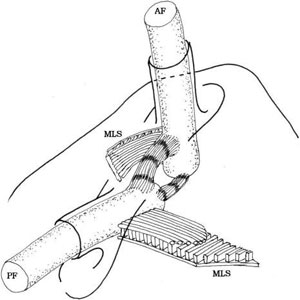Root System
All algal flagella appear to possess flagellar roots, that is, microtubular or fibrillar, often crossbanded structures, which extend from the basal bodies into the cytoplasm either underlying the
plasma membrane or projecting into the cell and making contact with other organelles such as
the nucleus, the mitochondria, the Golgi apparatus, or the chloroplasts. Diverse functions have
been assigned to the flagellar roots: anchoring devices or stress absorbers, sensory transducers,
and skeletal and organizational structures for morphogenetic processes.
The great diversity of morphology and arrangement of the flagellar root systems among the
different algae make it necessary to describe them separately in each division. As described
earlier, Cyanophyta, Prochlorophyta, and Rhodophyta lack any flagellar apparatus, hence they
will not be considered in the following.
Glaucophyta

FIGURE 2.48 Root system of Glaucophyta. AF, anterior flagellum; PF, posterior flagellum; and MLS, multilayered structure.
In the cyanelle-containing genera Gloeochaete and Glaucocystis, four roots are arranged in a cruciate manner, that is, four roots spreading out more or less evenly from the basal bodies. All four roots appear identical, each containing about 20 microtubules in Glaucocystis, and about 50 in Gloeochaete. In Cyanophora the roots are two. In all the genera each root contains a multilayered structure consisting of a band of microtubules, which overlies several layers of parallel plates (Figure 2.48).

FIGURE 2.48 Root system of Glaucophyta. AF, anterior flagellum; PF, posterior flagellum; and MLS, multilayered structure.





